2022 Manitou Dorado
Travel Options: 180, 190, and 203 mm (internally adjustable)
Wheel Sizes: 27.5’’ and 29’’
Available Offset Options: 47 mm (27.5’’) and 57 mm (29’’)
Stanchions: 37 mm
Test Duration: 7 months
Test Locations: Washington, British Columbia
Reviewer: 6’, 170 lb (183 cm / 77.1 kg)
Bolted to: Canfield Jedi and Nicolai G1
Stated Weight:
- Dorado Comp: 3,600 g
- Dorado Expert: 3,120 g
- Dorado Pro: 2,970 g
Blister’s Measured Weight:
- Dorado Expert: 3,237 g (29’’)
- Dorado Pro: 3,047 g (29’’)
MSRP:
- Dorado Comp: $1,300
- Dorado Expert: $1,550
- Dorado Pro: $1,950
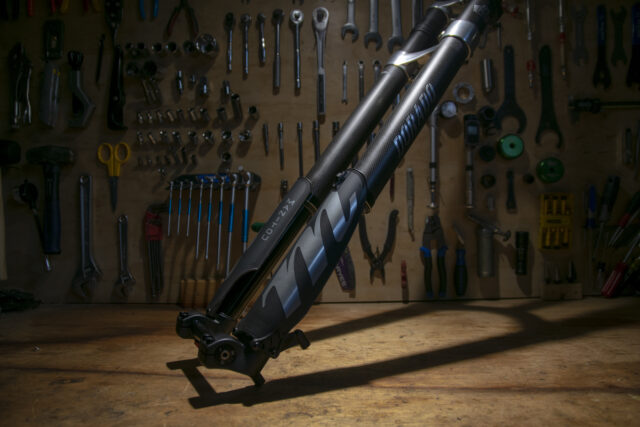
Intro
Manitou launched the current 37mm-stanchioned Dorado last year, and we talked about the new fork in a lot of detail with Manitou’s Phil Ott back in Ep.74 of Bikes & Big Ideas. Now that we’ve started spending time on the new Dorado — in both the “Expert” and “Pro” versions — we figured we were (over)due for a full writeup on the Dorado lineup, as well as our Flash Review with our initial on-trail impressions, which Blister Members can read now.
Design
The Dorado is now in its fourth generation, but it’s steadfastly held onto an inverted layout — a rarity in today’s market. It’s now got 37 mm stanchions (up by a millimeter from the prior generation) which Manitou says were chosen to strike their desired balance between chassis stiffness and other considerations such as weight and friction.
The main reason that tends to get cited for other brands not offering inverted forks is that inverted designs tend to be less torsionally rigid than conventional forks. But Manitou actually argues that a bit of torsional flex can actually be beneficial, to help keep the front wheel tracking more smoothly and getting knocked around less in rough sections.
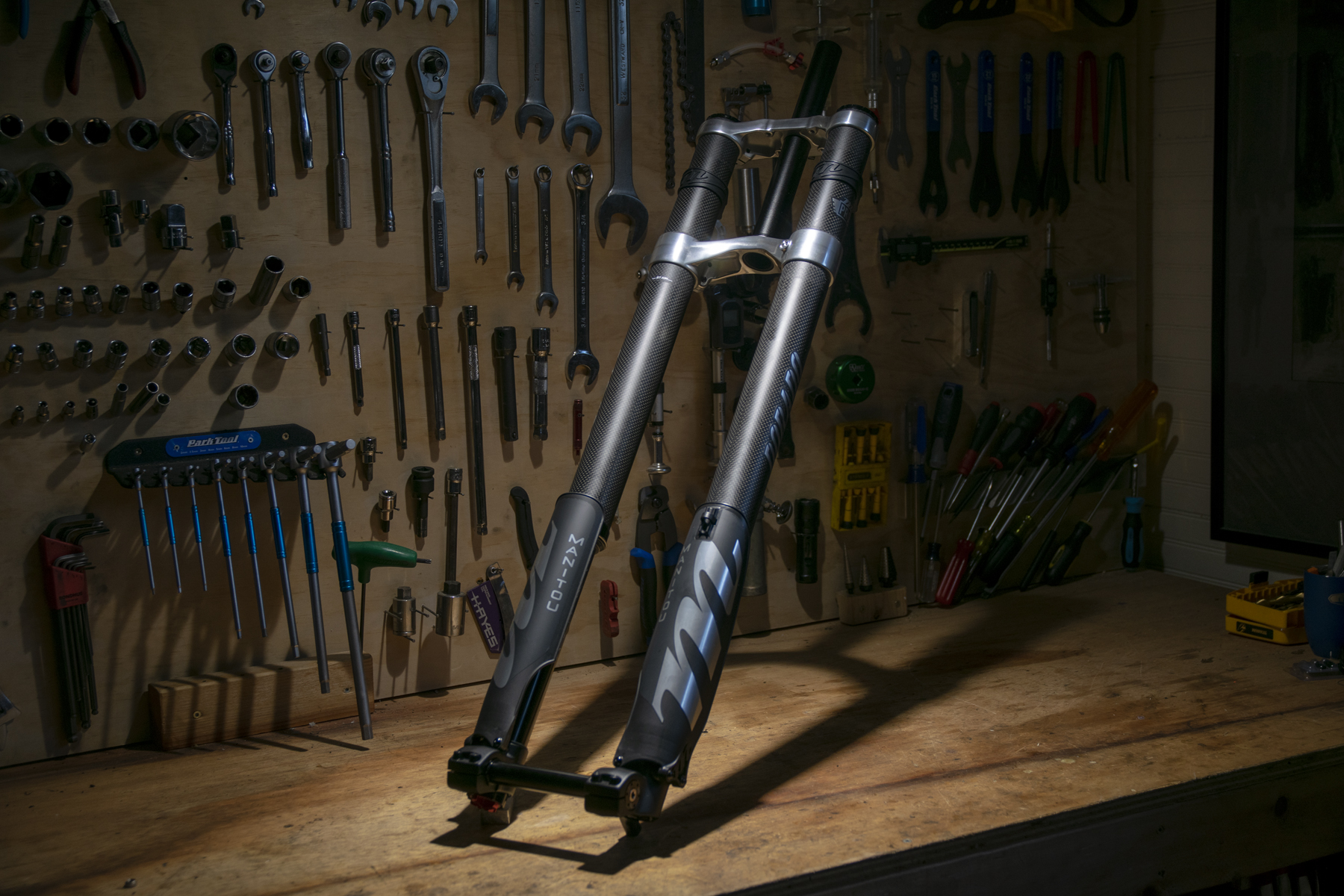
The key there, according to Manitou, is pairing a little bit of torsional flex with a chassis that’s quite stiff fore-aft, and an inverted dual-crown layout tends to excel in terms of fore-aft stiffness, largely because it can accommodate much longer bushing overlap than conventional designs. Manitou also notes that inverted layouts have advantages when it comes to lubrication, since the bath oil tends to pool at the seals and bushings, instead of at the bottom of the lowers where it needs to be splashed up to get to the moving bits.
The Dorado uses a 20 x 110 mm Boost front hub (though a 5mm rotor spacer to use a non-Boost 20 mm hub is included), and features a brake mount for a 203 mm rotor. Manitou says that rotors up to 223 mm and tires up to 67 mm wide are permitted.
Versions
Manitou offers three different versions of the Dorado, with substantially different chassis, spring, and damper designs throughout the line. The quick rundown is below:
Dorado Comp:
- Chassis: Aluminum
- Spring: Coil
- Damper: ABS+ (adjustable rebound and low-speed compression)
Dorado Expert:
- Chassis: Aluminum
- Spring: IVA Air
- Damper: TPC+ with hydraulic bottom-out (adjustable rebound, high- and low-speed compression)
Dorado Pro:
- Chassis: Carbon fiber upper legs
- Spring: IRT Air
- Damper: Sealed cartridge TPC+ with hydraulic bottom-out (adjustable rebound, high- and low-speed compression)
The main chassis difference between the three Dorado variants is the carbon fiber upper legs used on the Dorado Pro, in place of the aluminum ones on the Comp and Expert. Manitou says that the aluminum chassis in the Comp and Expert is 20% stiffer than the old 36mm-chassis model; the carbon fiber legs of the Pro bump that number up to 27%, and trim a claimed 238 g. (Our measured weights put the Pro 190 g lighter than the Expert all in, but there are additional internal differences that could also contribute, as we’ll get into below.)
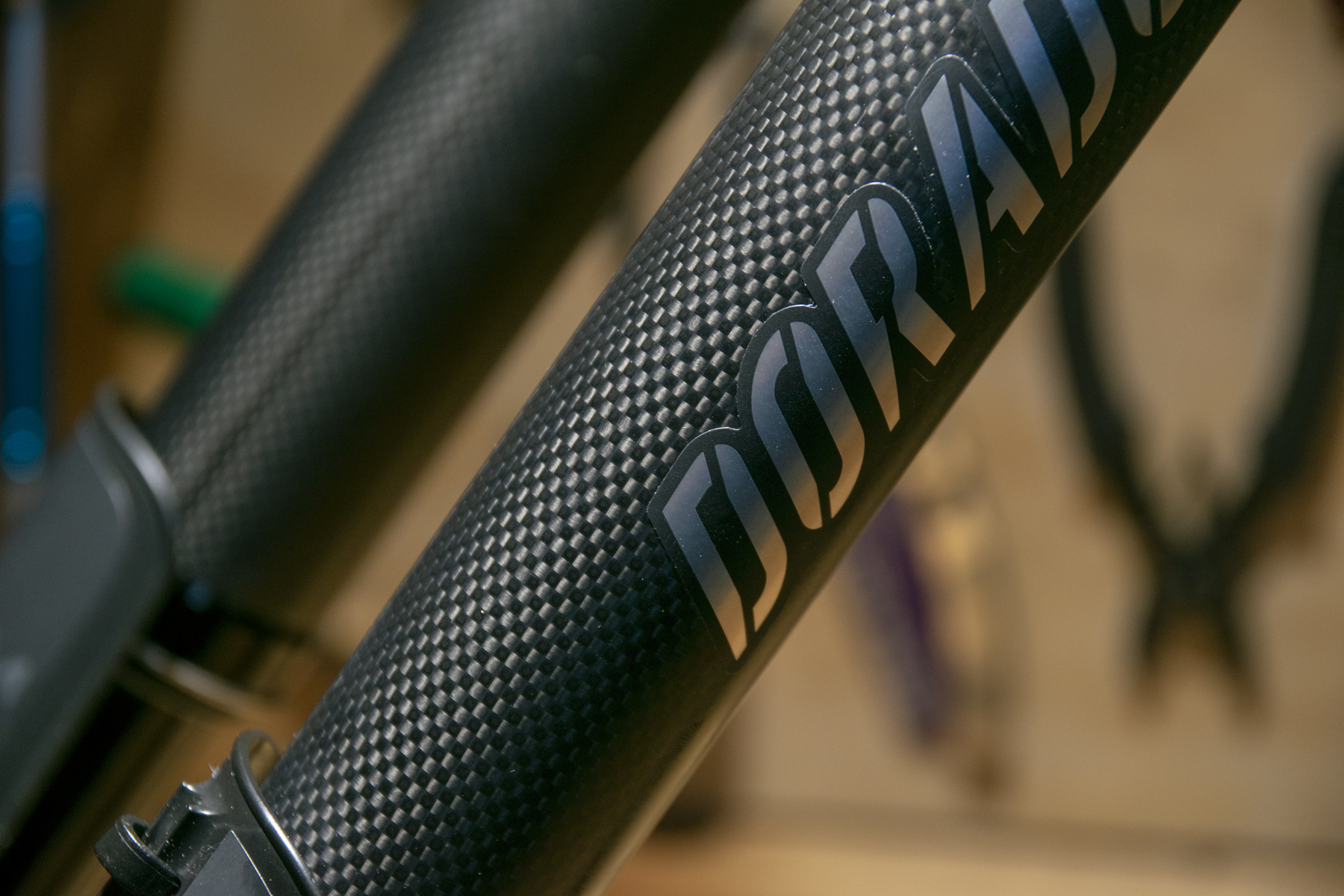
Since the Dorado uses an inverted design, there’s no need to swap lower legs to convert between wheel sizes, and the Dorado is compatible with both 27.5’’ and 29’’ wheels. The crowns intended for 29’’ use feature 57 mm of offset and a dropped upper crown; the 27.5’’ versions get 47 mm of offset and a flat upper crown. Since the 27.5’’ configuration uses a lower position for the lower crown, it, therefore, doesn’t need a dropped crown to accommodate a taller-stack headtube and headset combination. Both the 27.5’’ and 29’’ positions are marked on the upper leg for easy setup. If your total headset stack height is 121 mm or shorter, Manitou says that you can run the 47 mm offset crowns with a 29’’ front wheel if you’re after a shorter offset, though that total height will significantly limit the number of bikes that the short-offset 29er configuration works on. The crowns are functionally equivalent across all three versions, but the Pro comes with polished silver crowns, while the Comp and Expert get black ones.
Both the Dorado Comp and Dorado Expert feature Manitou’s threaded “Trail Side Relief” bleeder valves, which allow you to vent built-up air pressure in the legs by removing a screw from the top cap at the upper end of each leg; the Dorado Pro gets a push-button version, similar to the lower leg bleeder buttons featured on many of Fox and RockShox’s current forks.
Springs
All three versions of the Dorado get their own spring design, though it’s possible to swap them between chassis versions if you’re inclined to mix and match. All three spring versions can be set to 180, 190, or 203 mm of travel by moving spacers around internally. It’s not a trail-side job or anything quite that simple but only takes about 20 minutes once you’ve got the hang of it. The only tools that are required are a standard 16-notch bottom bracket tool, a cassette lockring tool, and a few standard wrenches.
IRT Air (Dorado Pro)
At the top of the heap is the Dorado Pro with its dual-positive spring IRT layout. It’s very similar to the design that Manitou uses (and that we’ve been hugely impressed with) in their Mezzer Pro single-crown fork, but configured for the bigger dual-crown chassis.
The way it works is fairly straightforward. Like most modern air-sprung forks, there’s a main positive air chamber with a negative chamber opposing it. Instead of using a dimple machined into the stanchion to equalize pressure between the two at top-out, the IRT spring equalizes pressures between the main and negative chambers when a shock pump is attached to the valve, but it works on the same principles as most other designs.
[If you could use a refresher on what all that stuff about positive and negative springs means, check out the “Design” section of our Vorsprung Secus review, which covers the subject in detail.]
But then Manitou stacks a second positive air spring chamber, called the IRT, for “Infinite Rate Tune” below the main air spring. The IRT chamber is filled by a second valve at the bottom of the fork leg, and should be pressurized before the main chamber to ensure a consistent setup.
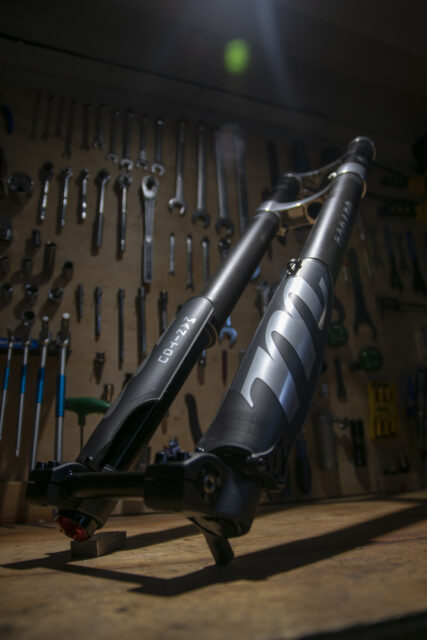
This means that they effectively behave as one larger chamber, and from that inflection point forward, the spring rate ramps up more slowly due to that larger total air volume. The idea is to make an air spring that offers increased midstroke support, due to the more aggressive ramp-up of the main chamber earlier in the stroke, without making the spring continue to ramp up as aggressively, making it difficult to use full travel, or resulting in harshness as the spring rate ramps up to the moon. And by varying the relative pressure in the main and IRT chambers, you can change where in the fork’s stroke that inflection point occurs, and thereby make significant changes to the overall shape of the spring curve, and with it the fork’s feel and performance.
Manitou isn’t alone in using a layout like this — Öhlins and EXT have done something similar in a number of their forks. As we’ve consistently found with various implementations of the concept, these sorts of dual-positive chamber designs make for forks that can be set up to be especially supportive without making the same kinds of compromises in terms of initial sensitivity / harshness or the ability to use full travel that you tend to get with more standard designs. This brings us to the Dorado Expert:
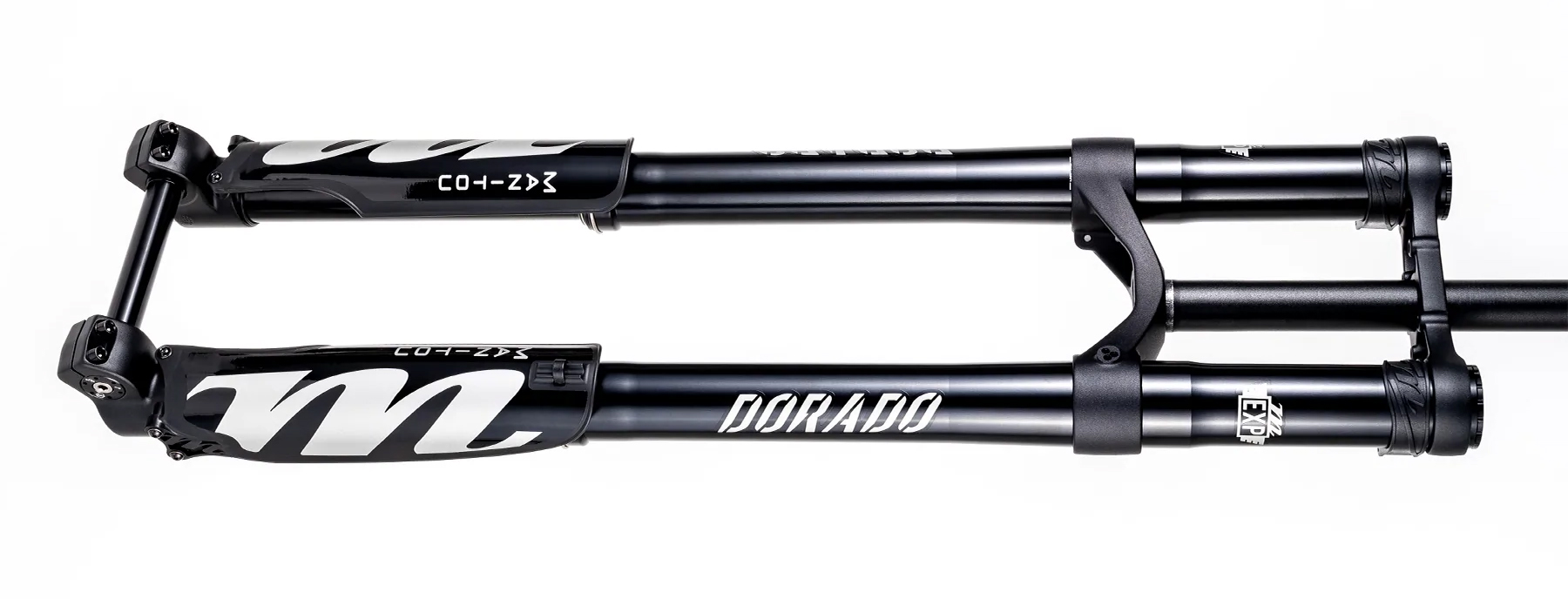
IVA Air (Dorado Expert)
The main part of the IVA air spring in the Dorado Expert is actually identical to that of the IRT one in the Dorado Pro — they use the same main positive and negative air spring assembly. The difference is that instead of using a second positive air spring a-la the IRT system, the IVA (“Incremental Volume Adjust”) spring replaces it with a non-moving piston that mimics the behavior of more conventional air volume spacers. Instead of adding or removing volume spacers to change the air spring volume and therefore the total amount of progression, the IVA system uses a piston to close off the main air spring, which can be set to one of three positions to produce different spring volumes. The result is functionally identical to that of normal volume spacers; IVA is just a different way of implementing the same idea.
Since the main half of the IVA spring is identical to the IRT one, it’s also possible to convert a Dorado Expert to the IRT spring from the Pro by simply removing the top cap and IVA assembly and dropping an IRT one in its place. Manitou sells the conversion parts on their own, and the swap only takes a few minutes.
Coil (Dorado Comp)
Finally, the base Dorado Comp uses a coil spring in lieu of the air versions in the Expert and Pro. That, of course, comes with a bit of a weight penalty (Manitou claims almost 500 g compared to the Expert) and some loss of fine-tunability, but should have some upsides in terms of small-bump sensitivity and reduced friction, and of course eliminates the need to maintain air pressure settings. Manitou offers six different spring rates for the Dorado Comp which they say cover riders from <125 lb to >225 lb (<57 kg to >102 kg); we’d of course expect there to be some limits to how far outside those ranges the spring range really covers.
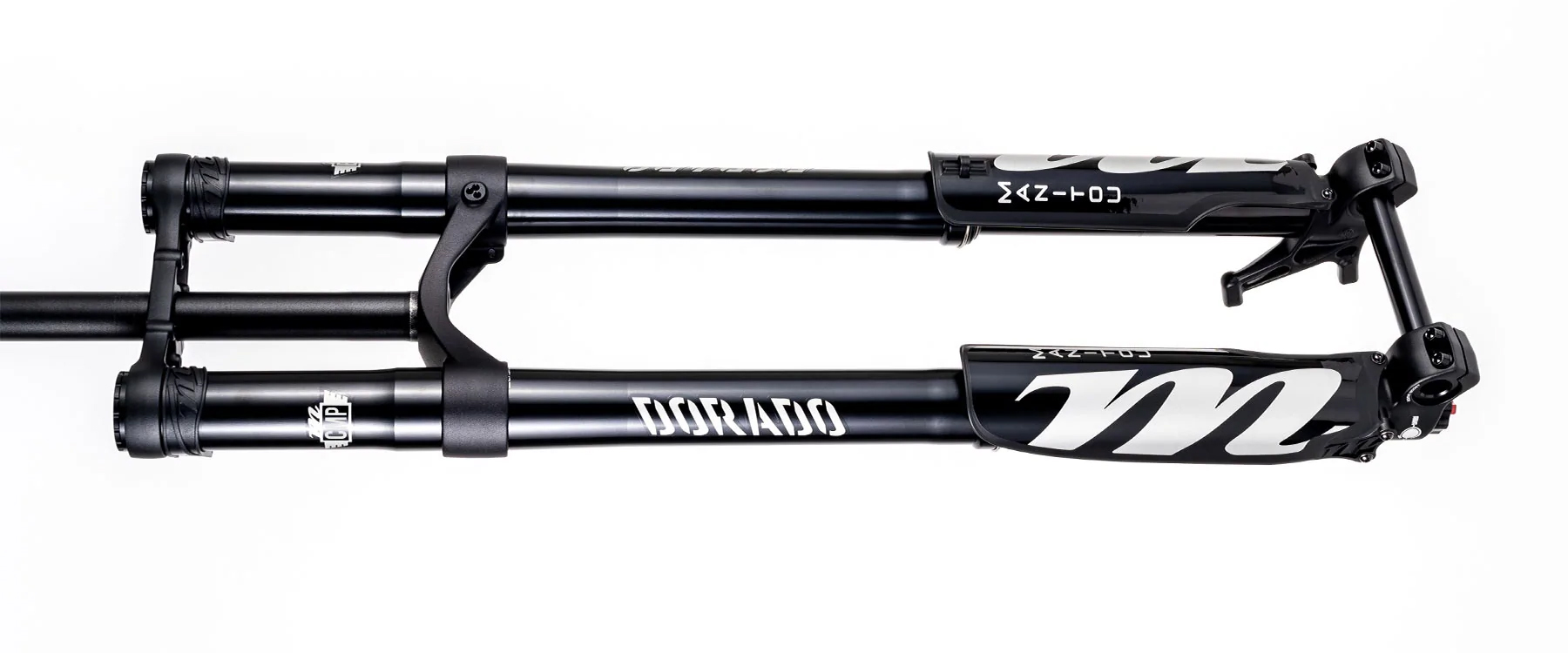
Dampers
All three versions of the Dorado also get different damper designs (though as with the spring versions, it’s possible to mix and match the different dampers into the other chassis). Once again we’ll start with the top-dog Dorado Pro and work our way down the line.
Sealed TPC+ (Dorado Pro)
The top-tier TPC+ damper used in the Dorado Pro is a sealed cartridge unit using a spring-backed IFP for oil volume compensation. Manitou says that the IFP arrangement allows them to lightly pressurize the oil from the beginning of the stroke (in contrast to a bladder design) to help prevent cavitation and produce more consistent damping. The damper is home serviceable but requires some basic tools as well as a syringe with the appropriate fittings to bleed the damper after reassembly.
The TPC+ damper features adjustable high- and low-speed compression and adjustable rebound. There’s also an additional hydraulic bottom-out (HBO) circuit which adds extra compression damping in the final 30 mm of travel to help control bottom-out events. The HBO circuit isn’t externally adjustable but could be re-valved as part of a damper service if desired.
TPC+ (Dorado Expert)
The Dorado Expert gets what Manitou calls a “half cartridge” version of the Sealed TPC+ damper in the Dorado Pro — which is to say, a similar overall design in terms of the compression and rebound circuits, but with the top part of the cartridge removed to produce an open bath design instead of the sealed cartridge with an IFP used in the Dorado Pro. This version of the damper has the same adjustments as the sealed version (high- and low-speed compression, plus rebound) as well as the same hydraulic bottom-out system, and Manitou says that its performance should be very similar to that of the top-shelf Sealed TPC+ version in the Dorado Pro, with the most significant difference being that the sealed cartridge version could potentially be a bit more consistent in its performance, especially over particularly long runs.
ABS+ (Dorado Comp)
The base model Dorado Comp gets a third damper design. Like the TPC+ damper found in the Dorado Expert, the ABS+ one in the Dorado Comp is an open bath design for simplicity, but it’s an entirely different design with more basic architecture than the TPC+ version. The ABS+ damper gets adjustable low-speed compression and adjustable rebound and forgoes the hydraulic bottom-out system of its higher-end siblings.
Flash Review
Blister Members can read our Flash Review of the Dorado Expert and Dorado Pro for our initial on-trail impressions. Become a Blister Member now to check out this and all of our Flash Reviews, plus get exclusive deals and discounts on a ton of great gear, and personalized gear recommendations from us.
On the Trail
The Manitou Dorado has been around for over 20 years now, and while a whole lot about its design has changed over the years, the Dorado has held fast to its inverted layout. That makes it an unusual offering in today’s market, but the latest 37mm-stanchioned Dorado makes a convincing case for itself on the trail.
I’ve now spent a lot of time on both the Dorado Pro and Expert, at 190 mm travel on my Nicolai G1, and in full 203 mm guise on the Canfield Jedi 29. Having been a very big fan of Manitou’s Mezzer Pro over the last few years, I’m pleased to say that a lot of what’s great about that fork carries over to its bigger, inverted siblings, with just a few little quirks.
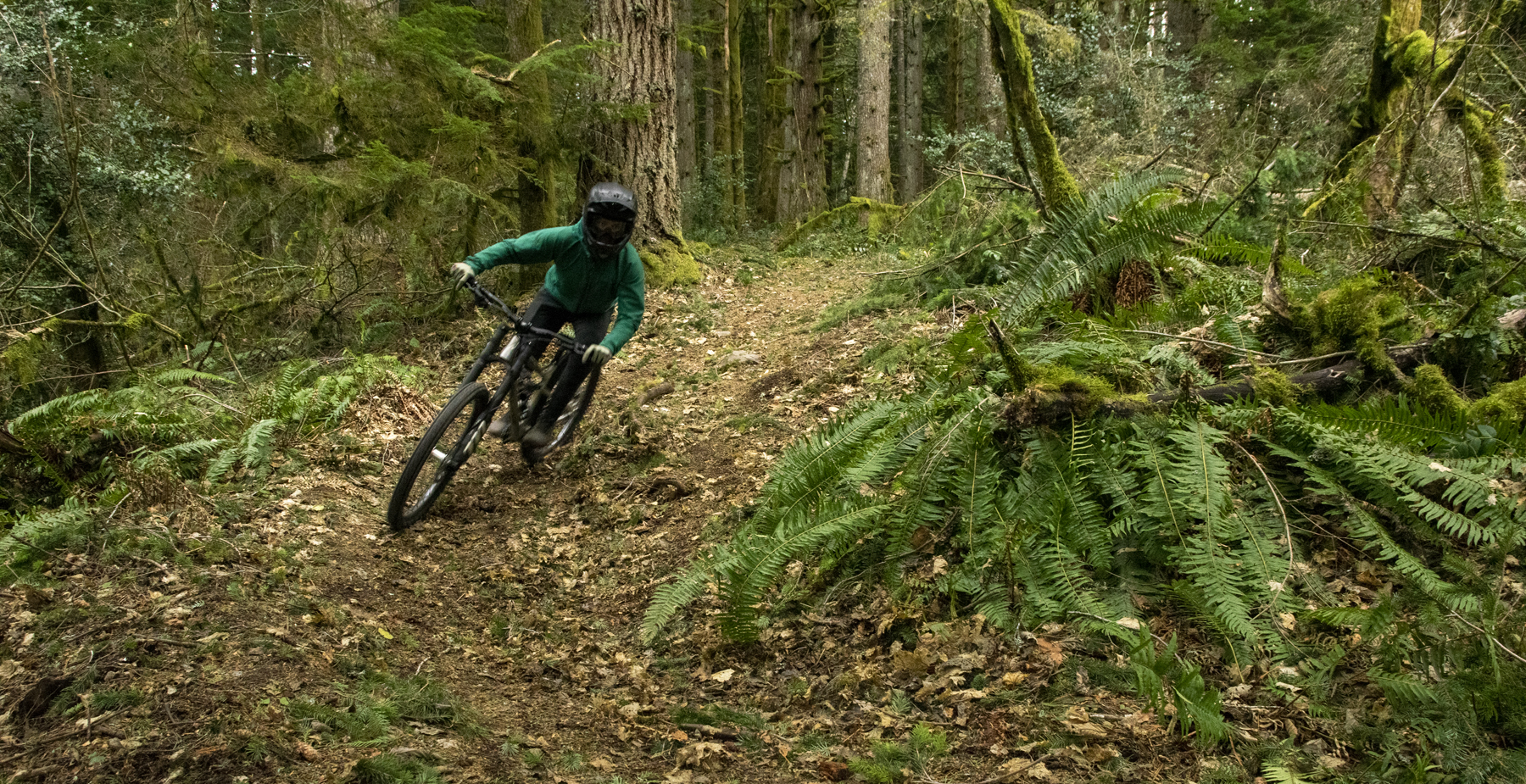
Setup and Performance
One of the most outstanding attributes of the single-crown Mezzer Pro is just how much midstroke support its dual-positive chamber IRT air spring can be tuned to provide without feeling unduly stiff or harsh overall, and the same is true of the Dorado Pro — which shares the same overall spring design. Manitou’s setup guides are especially detailed and helpful, with three sets of recommended pressures for low, medium, or high overall progressivity across a range of rider weights.
With the Dorado Pro, I found myself running something in between the mid and max progressive settings for roughly my weight (170 lb / 77.1 kg), with 57 psi in the main chamber and 110 psi in the IRT one, with the fork at its full 203 mm travel setting (and a few psi higher in both when lowered to 190 mm to compensate for the reduction in travel).
And with that combination of settings, the Dorado Pro’s air spring feels outstanding. Midstroke support is exceptionally good for an air-sprung fork while still maintaining excellent small-bump sensitivity; it does take me an especially hard landing (read: a substantial mistake on my part) to get into the last 10–15 mm of travel, but as I’ve said repeatedly on here, using every millimeter of available suspension travel essentially doesn’t even make it onto my list of priorities when it comes to setup, and I’d much rather just tune for what performs well. (And for what it’s worth, Push Industries founder Darren Murphy agrees with me — check out our chat in Ep.107 of Bikes & Big Ideas for his take.)
In the case of the Dorado Pro (and my personal preferences), that does mean running more IRT pressure in order to bolster midstroke support, which makes the fork a tad too progressive for me to use all the travel with much regularity, but I’m 100% fine with that. I loved the IRT spring in the Mezzer Pro, and I still love it in its reconfigured form for the Dorado Pro.
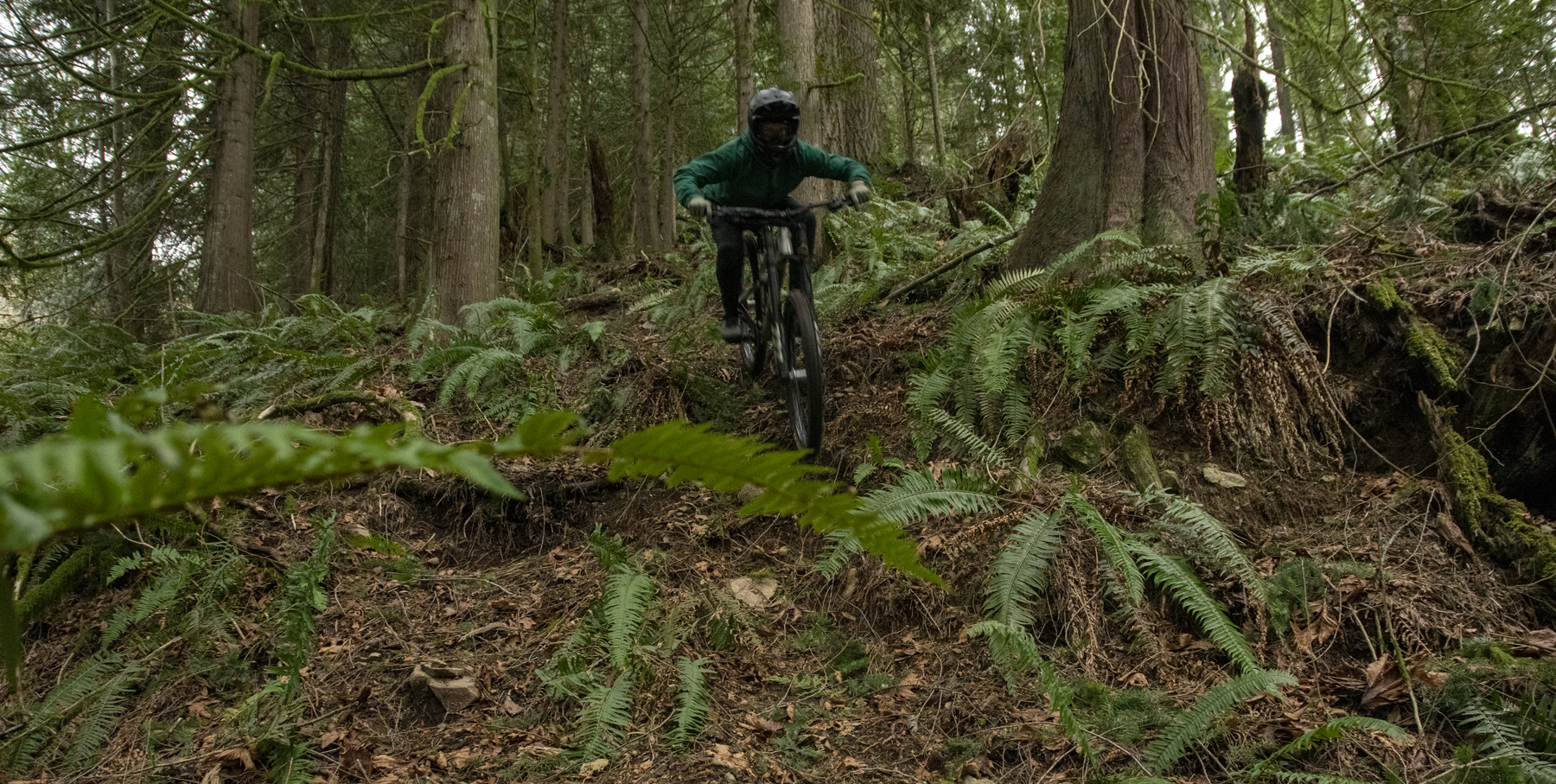
Things are a bit different in the Dorado Expert, with its more conventional single-positive chamber IVA spring, as tends to be the case with such designs — again, because I’m starting from the point of wanting to emphasize midstroke support and essentially working backward from there. Since the volume adjustment provided by the IVA system (which to reiterate, is just another way of achieving a similar outcome as adding or removing volume spacers in other brands’ forks) has a greater impact deeper in the travel than the IRT system does, I wound up preferring something closer to Manitou’s less progressive setup, but with a bit higher air pressure — the IVA piston set to position 1 (highest volume) and 78 psi.
That combination worked quite well for me, though neither small-bump sensitivity nor midstroke support was quite as impressive as with the IRT spring in the Dorado Pro. I was able to use more or less full travel more regularly without feeling a full bottom-out, but, again, I’d gladly leave a little travel on the table in exchange for better performance elsewhere, and so while the IVA spring in the Expert worked quite well overall, the IRT one in the Dorado Pro does feel like a real upgrade.
In the case of the stock IVA spring in the Expert, I was definitely making greater compromises to small-bump sensitivity in order to get the support I wanted than I did with the IRT spring — so it’s probably fair to say that the two are more similar in terms of small-bump sensitivity, with the IRT spring having the significant advantage in terms of midstroke support. If you’re inclined to try to set up the IVA spring to close that gap a bit, small-bump sensitivity suffers somewhat. If midstroke support is less of a priority and you set up the IVA spring accordingly, its sensitivity is still quite good.
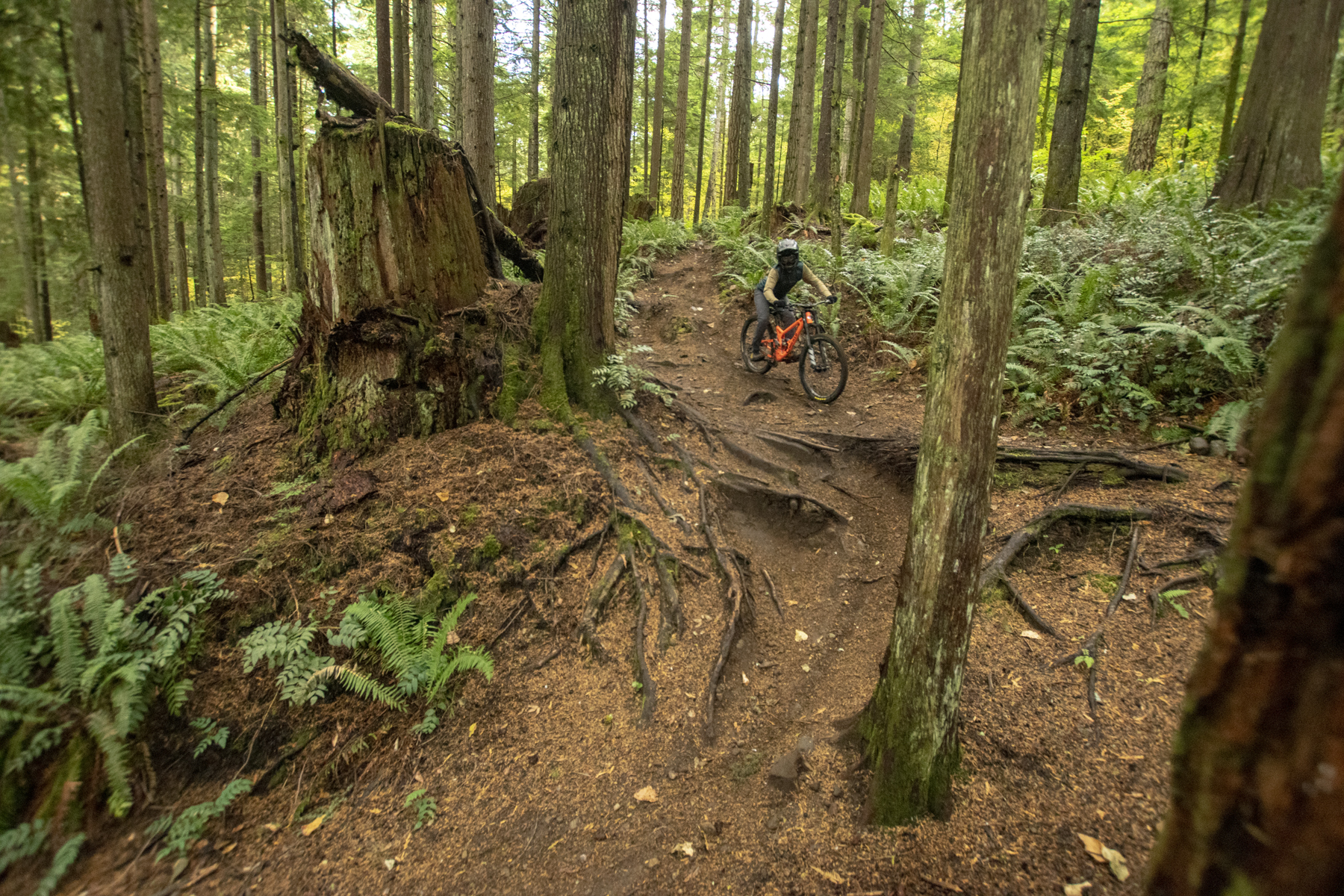
The good news there is that Manitou sells the IRT kit for $110, and swapping it into a Dorado Expert takes just a few minutes (and in fact, can be done with the fork still installed on the bike — just remember to let all the air pressure out). I borrowed the IRT assembly from the Dorado Pro to try that setup in the Expert (does that make it a Semi-Pro? Or an Ex-Pro?), and the results were as expected — the improved support and small-bump sensitivity that I felt in the stock Dorado Pro mostly carried over with the spring upgrade.
That’s not to say that there are no discernable differences between the dampers in the two forks, but they’re a lot more subtle than the changes to the springs. And that’s maybe not a huge surprise — the overall architecture of the two is largely the same, with the principal difference being that the TPC+ damper in the Dorado Expert uses an open bath configuration, while the Sealed TPC+ version in the Pro is, well, sealed, with a spring-backed IFP to handle oil volume displacement. In practical terms, that mostly means that the damper in the Pro version is a touch more consistent on longer, faster, rougher runs, where the TPC+ damper in the Expert can feel a little quicker to fade, presumably as some air gets introduced to the oil. To be clear, this moderate reduction in damping was neither dramatic nor easy to introduce, but rather something that I had to pay relatively close attention to in order to notice. Heavier, more aggressive, faster riders are likely to notice more, but I don’t think it’s likely to be a big deal for most folks.
On the flip side, the open bath design does make the TPC+ damper in the Expert easier to service, since there’s no need to bleed the damper upon reassembly, and apart from the slight reduction in damping that I could occasionally induce on some longer, faster runs — think taking a full pull down Schleyer to Canadian Open at Whistler, at pace — its performance is genuinely very close to that of the sealed version in the Dorado Pro.
[The Dorado Expert does also lose damping briefly if it’s left upside down, such as on a chairlift where the bike is hung by the front wheel, but it’s quick to recover once it’s put back upright and the oil drains back into the damper. Unless you’re adamant about dropping in the instant you get off the lift, I don’t see that being a real issue for most folks.]
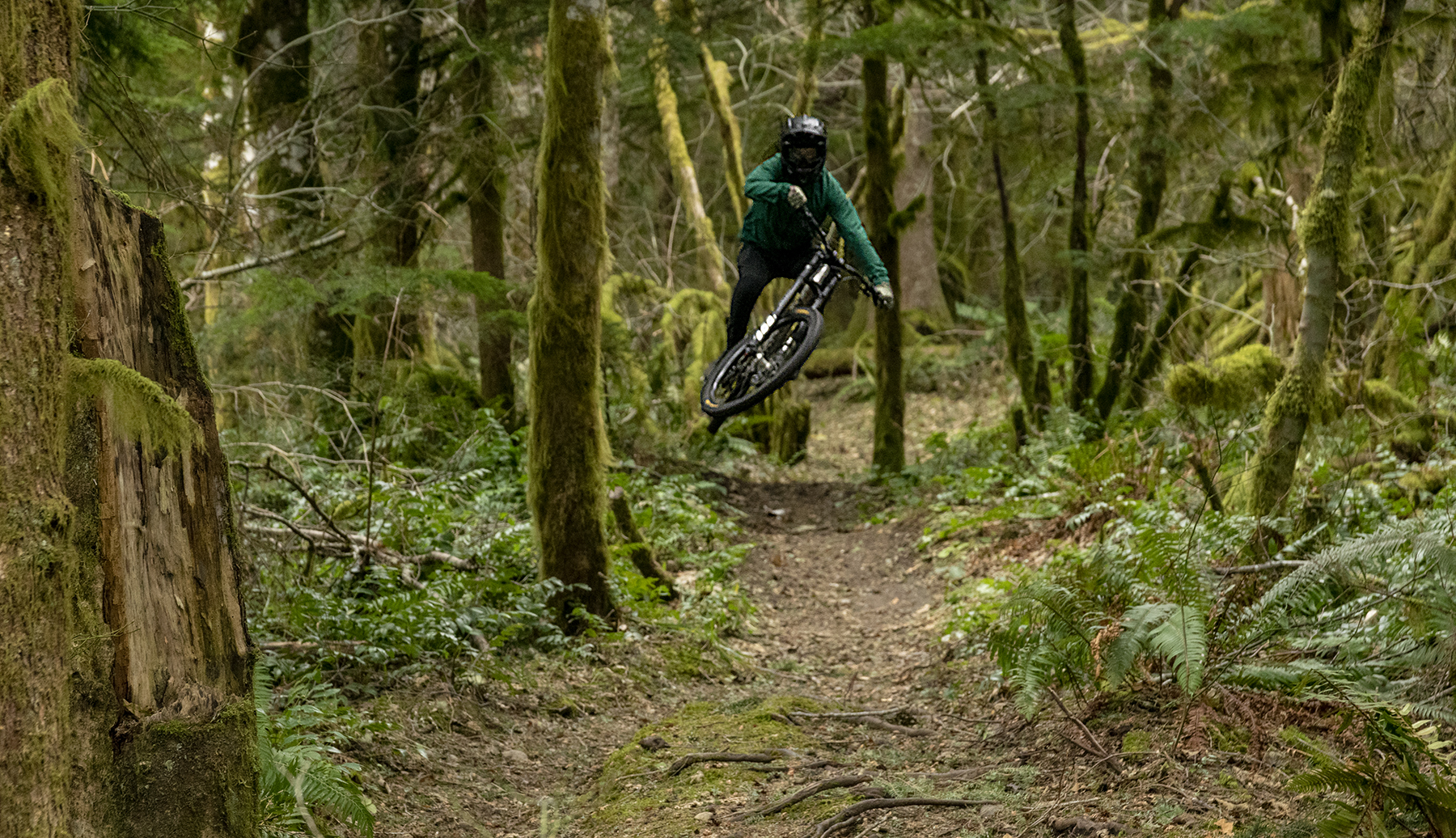
Both dampers feel moderately firmly valved (especially in comparison to the newer Grip2 VVC damper in the current Fox 40, which is especially lightly damped) but have a relatively wide range of adjustments, and do a good job of not spiking or feeling unduly harsh when running comparatively firm compression settings. The Charger 2.1 damper in the current RockShox Boxxer is also capable of generating firmer compression damping than the Grip2 VVC, but probably not quite as much as Dorado dampers, and it does feel more harsh at firmer settings. A number of RockShox’s athletes have been spotted riding what appears to be a new Boxxer with the excellent Charger 3 damper that debuted in their single-crown forks last year, but it’s not available to the general public at this point.
Chassis Stiffness & Offset
One of the things that I was most curious about with the Dorado was how its chassis stiffness, especially in torsion, was going to feel. Particularly given that I’ve found the newer, burlier class of single-crown forks (RockShox ZEB, Fox 38, Öhlins RXF 38, et. al.) to be quite beneficial on longer-travel bikes for their added precision and improved suspension performance, due to reductions in binding as the fork flexes, would the (theoretical) reduction in torsional stiffness from the inverted chassis be a problem? Or would I even notice?
The answer to the latter question is a clear “yes”; the former is more complicated. Compared to the RockShox Boxxer and (especially) the Fox 40, both versions of the Dorado are notably less stiff in torsion. But somewhat to my surprise, I mostly found that difference to noticeable, but not something that had all that great an impact on my riding experience in most situations.
(Manitou claims that the carbon chassis of the Dorado Pro is slightly stiffer than the aluminum one used in the Expert, and that does feel right, but the difference is subtle. The two Dorado versions are much more similar to each other than they are different, so for simplicity’s sake I’m just going to mostly refer to both as the Dorado throughout this section, and differentiate between the two only when relevant.)
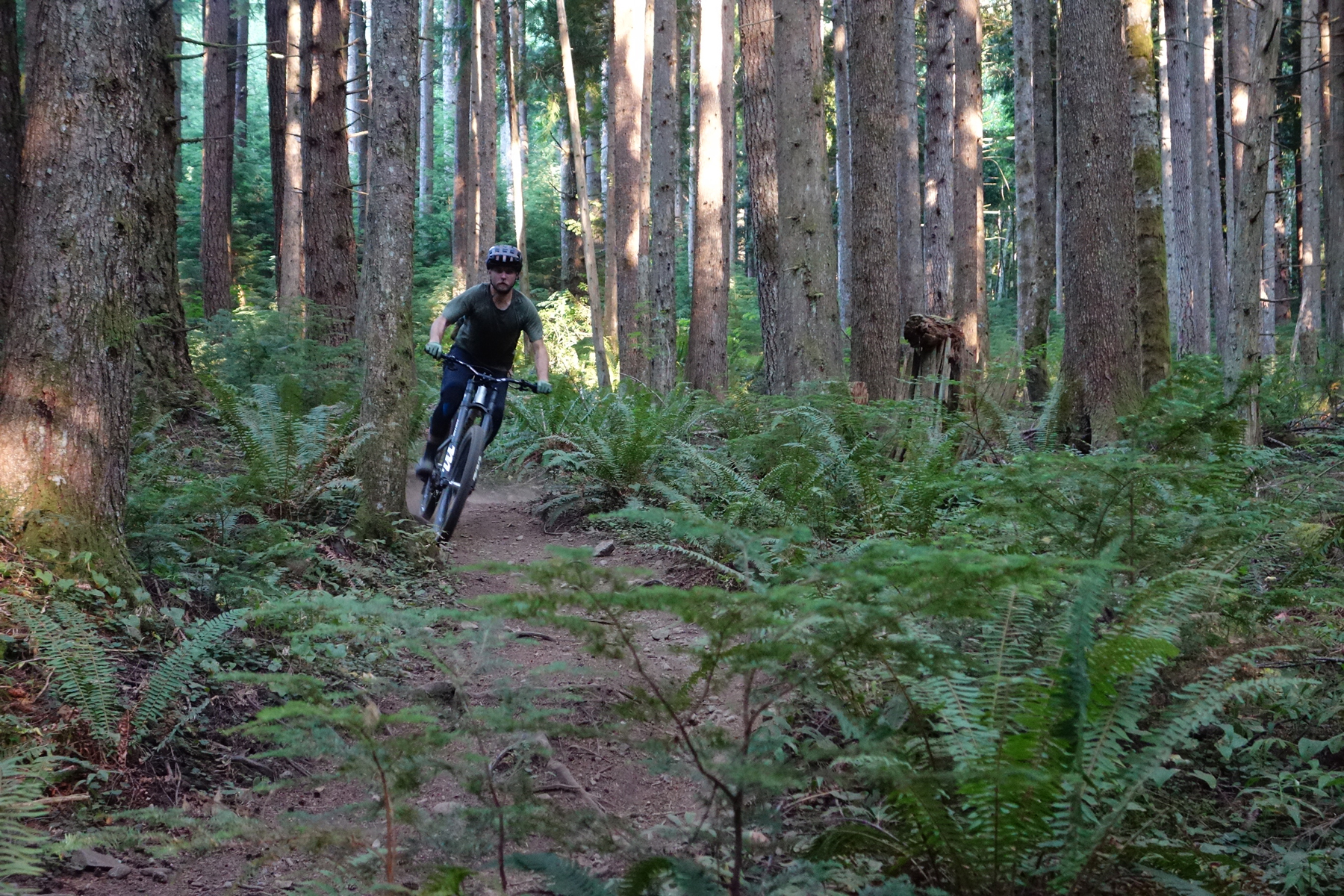
I swapped back and forth between the Dorado and a Fox 40 several times over the course of my testing to A-B the forks against each other, and each time I went from one to the other, I had a thought along the lines of “oh wow this feels pretty different” regarding chassis stiffness, and then after a few minutes of riding mostly forgot about it. The Dorado does clearly feel less stiff and less precise in torsion, but I found it easy to adapt to and didn’t find that loss of precision to be all that great a problem. Maybe I was having to make more minute steering corrections to account for the front wheel twisting than I might on the 40, but my hunch is that mountain biking just involves so many slight steering corrections as the front tire slips, pings off rocks and roots, and so on, that it’s pretty easy to manage those because we’re simply used to doing it. And, crucially, unlike with lighter-duty single-crown forks and their burlier counterparts, the reduced torsional stiffness of the Dorado isn’t paired with a reduction in fore-aft stiffness.
Riding the Dorado helped me realize that, when comparing the different single-crown forks (e.g. a Fox 36 vs. a Fox 38), the change in fore-aft stiffness seems to make a bigger difference in how the fork actually performs, especially in longer-travel configurations and on bikes with slacker headtube angles, which put greater fore-aft loads on the fork. Some torsional flex, I can live with; lots of fore-aft movement both makes the fork more prone to binding / feeling terrible, and can feel ping-y and undamped as the fork rebounds from that flexed state. The Dorado doesn’t feel super precise torsionally, for sure, but it also doesn’t display the other downsides that I tend to associate with flexy forks (because it’s quite stiff fore-aft), and that’s a tradeoff that I’m pretty happy with.
Manitou’s claim that the torsional flex actually helps the Dorado track cleanly because the front wheel can twist a little instead of pinging off roots and rocks is harder to evaluate. The Dorado (especially the Pro) does clearly transmit less feedback from small chatter to the rider than the Fox 40 or RockShox Boxxer, but whether that’s down to the chassis, the spring, the damper, or some combination thereof is trickier to tease out. The Dorado Pro’s combination of small-bump sensitivity and great midstroke support is especially impressive, and while the Expert is still pretty good, the IRT air spring in the Pro makes it a lot easier to balance both traits with fewer compromises, if you get the setup dialed. But in absence of the ability to isolate all the variables between the different designs, I don’t feel all that confident about confirming (or refuting) Manitou’s claims on that front.
To put a bow on all of that, do I think that I’d like the Dorado even better if it was stiffer torsionally? Probably a little bit. Do I think that its modest torsional stiffness is going to be a deal breaker for most people? Nope. And the chassis — whether the aluminum or carbon fiber version — does feel notably low friction and less prone to binding and sticking than most of its competitors. Whether that’s specifically attributable to the inverted layout or just a testament to the work Manitou has done to dial in the chassis and sliding surfaces is tough to state for sure, but the results are impressive.
One of the other quirks of inverted dual crown forks is the potential for the legs to slip in the crown clamps, leaving the fork twisted until you loosen the crowns up and reset everything. (Yes, it’s possible to do this with conventional dual crowns too, but it’s a lot harder.) And in particular, I had some trouble with the carbon fiber chassis on the Dorado Pro being prone to twisting. The legs come with a textured grippy coating applied in the crown clamping areas, but I found that it wore off and lost efficacy after some use and that it became easier than I’d like to get the crowns to twist.
Adding carbon assembly paste to the interface solved the issue in all instances short of one pretty big crash where the front wheel got caught and twisted as I went down; the grippier aluminum chassis of the Dorado Expert didn’t give me the same trouble. It wasn’t like the Pro was twisting on me all the time or anything, but a hard yank on the bar with the front wheel caught on a rock and unable to turn freely, or even a really hard slap of a berm (particularly once the stock grip coating had worn down, and before I’d added the carbon paste) could do the trick. Resetting it wasn’t ever hard, and it was rare for me to twist the crowns by more than a couple of degrees (i.e., not so badly that it caused a major issue) but it has been a minor annoyance.
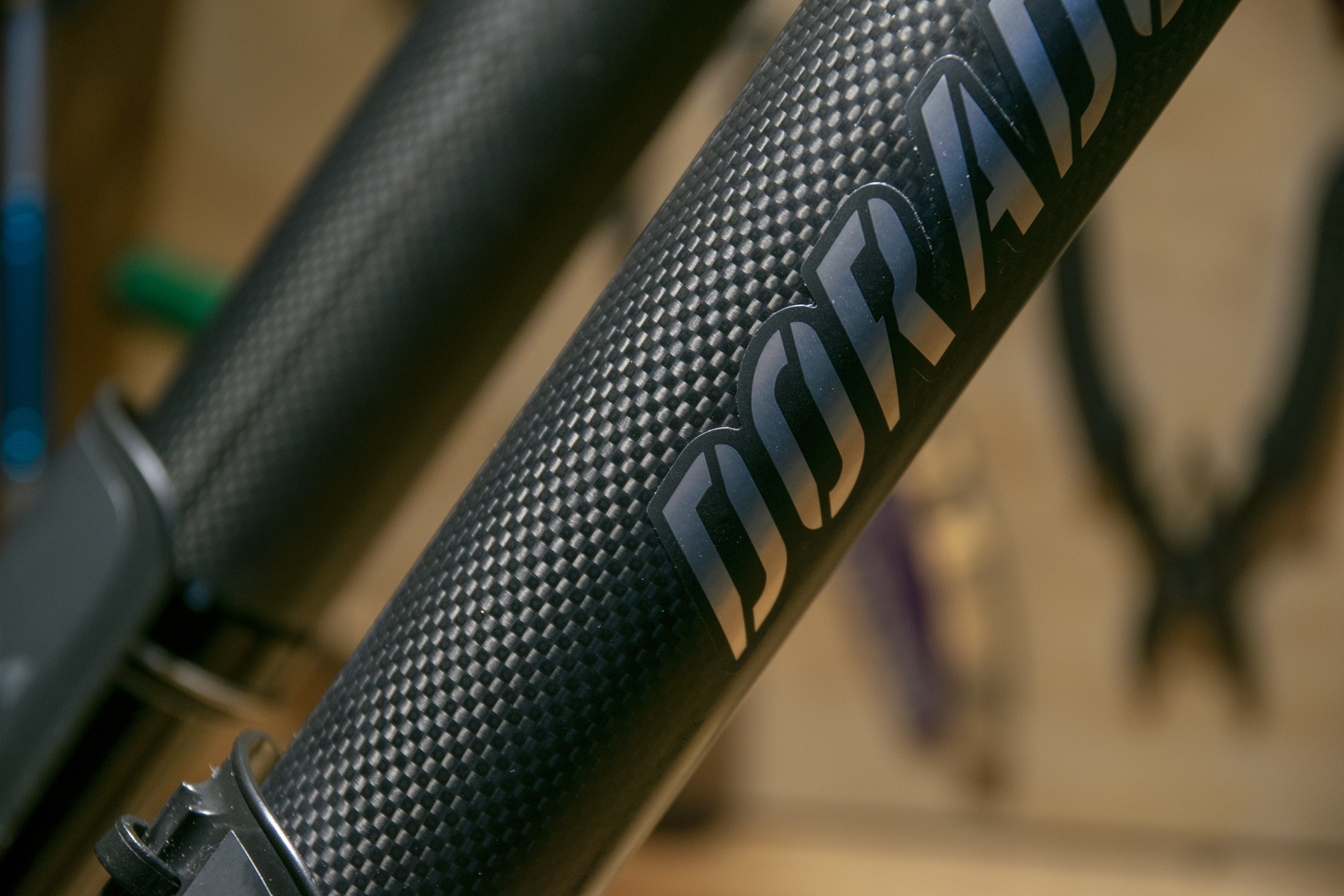
I only ever rode the Dorado with a 29’’ front wheel, but did experiment with both the stock 57 mm offset crowns and the 47 mm offset version, designed for the 27.5’’ wheel configuration. Since both test bikes had total headset stack heights greater than Manitou’s 121 mm maximum for the flat 27.5’’ top crown in the 29’’ configuration, I needed to sub in a Rulezman drop crown to make the configuration work (an earlier version of Manitou’s documentation stated the limit at 124 mm, and I’d hoped that there’d be enough wiggle room for me to make the stock flat crown work on a 120 mm headtube with a Cane Creek Slamset, but that was not to be).
Anyway, the results were pretty much in keeping with my past experiences experimenting with fork offset — mostly that the longer 57 mm offset felt a little bit quicker steering, while the 47 mm option slowed the steering down a touch and made those inputs feel more stable. The effects are particularly noticeable at medium speeds, where you’re going fast enough to be making relatively subtle bar movements, but still adding some steering input, instead of mostly just leaning the bike into the turn.
If you want a much deeper dive into fork offset and why it matters, check out our MTB 101 article on the subject, here. But generally speaking, I found myself with a slight preference for the shorter 47 mm offset most of the time. It’d be great to see Manitou add a 47 mm offset drop upper crown to their offerings to make that combination more readily available for folks on 29ers, but I didn’t find the 57 mm version to be clearly, dramatically too much, either. I imagine that most people running a 29’’ wheel will be fine with the stock offset; if you’re especially particular about wanting shorter, and have a bike with a taller headtube, get in touch with Rulezman.
The final minor quirk of the Dorado’s inverted layout is that it makes installing a fender a trickier proposition since there’s no arch to affix one to. You can ziptie one to the lower crown, but they’re less effective up that high, with so much extra distance between the fender and the tire. It’s not a big deal, but it’d be great to see Manitou come out with a more elegant solution — such as the combination fender and stanchion guards that they offered for the prior-generation fork.
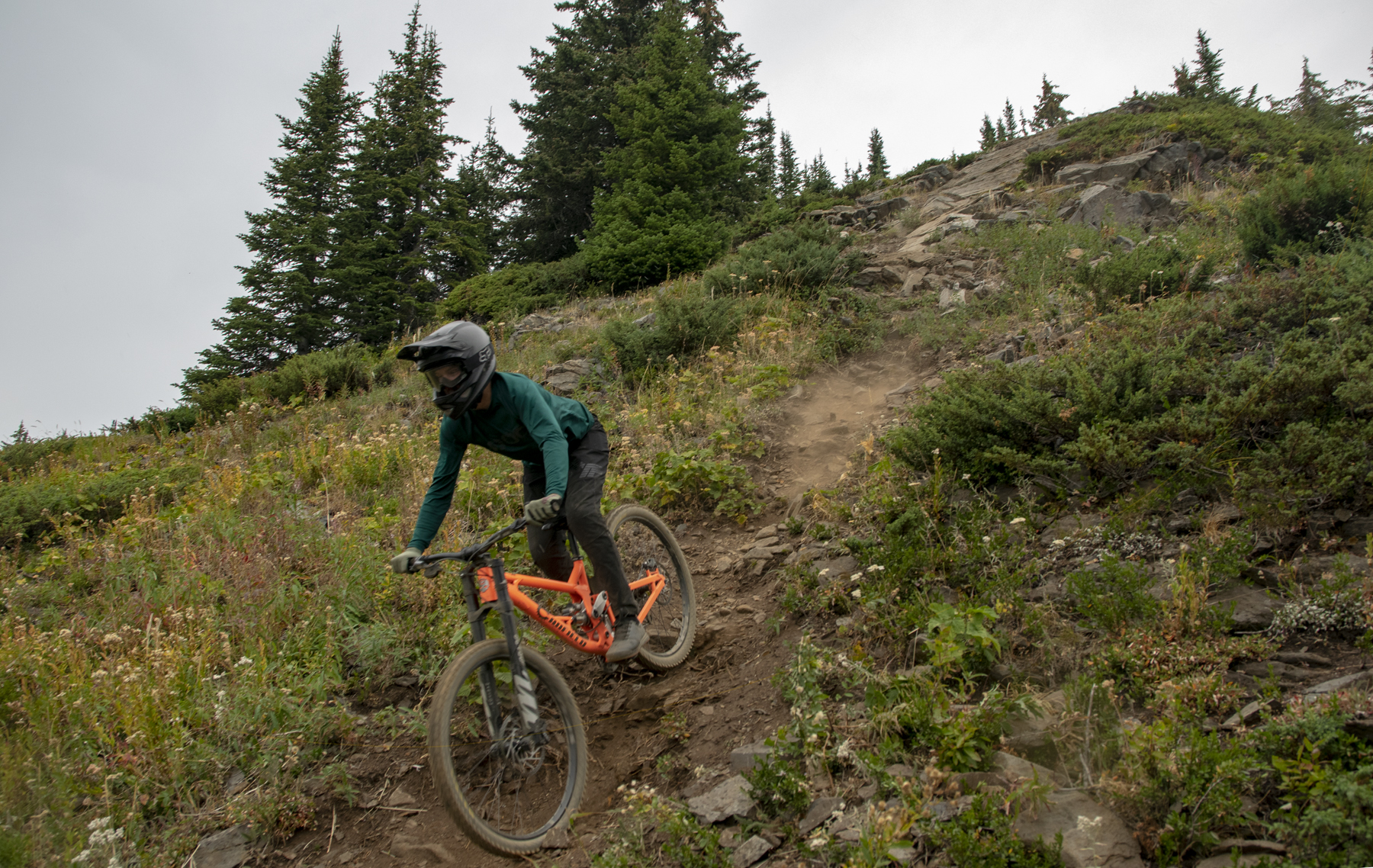
Who’s It For?
Both the Dorado Expert and Pro are compelling options for folks in the market for a dual-crown fork. Their dampers are excellent, the chassis are especially smooth-sliding and low friction, and both have especially good small-bump sensitivity; the IRT air spring in the Pro is particularly compelling for folks who care a whole lot about midstroke support and tend to run setups that emphasize it, often to the detriment of small-bump sensitivity and front end grip. The inverted layout has its quirks, but I honestly found the lack of torsional stiffness to be far less of a big deal on the trail than I thought it might be, and while both versions of the Dorado do feel noticeably less precise in their steering than the RockShox Boxxer or (to an even greater extent) the Fox 40, it’s been surprisingly easy for me to adapt to that extra bit of flex and just get on with my riding.
I do think that the Dorado Expert with the IRT spring upgrade is a nice sweet spot for a lot of folks who are interested in the Dorado. It’s cheaper than the Pro but offers very similar performance with less likelihood of twisting the chassis in the crowns; the carbon Pro chassis is lighter, fractionally stiffer, and looks great, but the biggest reason to spring for the top-tier Pro is for the very slightly more consistent sealed damper. That will be worth the money for very aggressive, fast riders but a minor difference for most people.
Bottom Line
The Manitou Dorado occupies an interesting place in the dual-crown fork market. It’s one of the last remaining inverted forks and is substantially less stiff torsionally than its conventional competitors, but I’ve been surprised by how little that’s mattered to me in practice. Combine that with a pair of very good dampers and the option for the excellent, ultra-supportive IRT air spring, and the Dorado is far more than just a novelty throwback. It rides substantially differently from its competitors in a lot of ways, for both better and worse, but the upsides are substantial, and folks who aren’t put off by the modest torsional stiffness are going to find a lot to like here.

Great review. I’ve been wanting to try a dual crown fork on my G1, and am kinda holding out for EXT to come out with something, but the Dorado sounds like a good option.
I saw that Rulezman crowns were running low so I wound up taking the plunge. Crowns from Rulezman, fork (sold sans stock crowns – thanks Dirt Labs!), and Straitline DM stem incoming. Very excited for what I imagine will be a pretty significant performance upgrade from my current Lyrik Ultimate.
I have a Dorado Pro on my G1 and love it. Best performing fork I have owned.
“One of the other quirks of inverted dual crown forks is the potential for the legs to slip in the crown clamps, leaving the fork twisted until you loosen the crowns up and reset everything.”
“It wasn’t like the Pro was twisting on me all the time or anything, but a hard yank on the bar with the front wheel caught on a rock and unable to turn freely, or even a really hard slap of a berm (particularly once the stock grip coating had worn down, and before I’d added the carbon paste) could do the trick.”
I’m sorry, I’m having a hard time understanding what these are describing. Can anyone rephrase what’s being described here?
Yeah, he is slightly mistaken on that one, what usually is getting twisted (mostly on falls) are not the pipes in the crowns, but the legs relative to each other trough the trough-axle-making friction in the bushings
It’s absolutely the uppers twisting in the crowns in this case. The hexagonal axle on the Dorado keeps that end from going anywhere.
I have a boxxer on my G1 (seems to be a lot of people with G1’s in the comments lol) and love the steering precision and not having to worry about creaking but hate the air spring and it’s lack of midstroke support.
– David, I was really thinking of selling my boxxer and getting one of these simply for the better air spring(which you again confirmed). My other though was to put a Secus on my boxxer. Do you think a Secus on a boxxer would get close to this for mid stroke support? Or should I just get one of these. I’d love your thoughts, thanks!
motorcycles use this type of fork
For a reason it’s physics don’t fall for the marketing bullshit of the big brands they’re garbage
Telescopic dh forks with bigger stanchions like Fox40 is just plain silly, tire clearance is so tight and why not going inverted like Manitou Dorado, ample of clearance. Dirt bikes had been using inverted why not mtb.
What travel were you able to run on your G1 with the 47mm offset drop crown? Could you get 190mm to work with that head tube and offset or what did you settle on? What do you think is optimum there for the G1? Thanks
David could you share your impression of riding the G1 with the Dorado set at 190mm? I’m on a G1 currently in the 175mm rear travel mode and running the Ohlins RXF 38m2 with a Smashpot set to 180mm. I find myself riding more bike park and shuttling on this bike recently and am thinking about tossing the Ohlins fork on another bike and possibly going Dorado pro set to 190mm on my G1. Curious if the bike felt balanced / unbalanced at 190 front, 175 rear and also how the Dorado Pro felt with the Storia.
Thank you for a great review. Any impressions on Öhlins DH38 m1 vs Dorado Pro? Seems air spring wise they should be close?
Öhlins are not the same like Dorado
Dorado irt is a 3 air chamber Öhlins dont have this Öhlins Air Chamber is the same Like Tokkens in boxxer or 40 !!!
Boxxer /fox 40 more tokkens Ramp up
öhlins more pressure in Chamber Ramps up
So not the same Like Dorado
The Ohlins spring packages the three air chambers differently than the Dorado one does, but it works on exactly the same principle. It’s still a dual-positive design with a floating piston separating the two positive chambers. It’s functionally much more like the Dorado spring than it is like a volume spacer based system.
Would you say the torsional stiffness is more or less than a Mezzer Pro? I have a Crestline e-bike with Mezzer Pro at 180mm and thinking of trying the Dorado Pro…but I once tried an Intend Edge (at 180mm on a pedal bike) and the torsional flex scared me on steep tech.